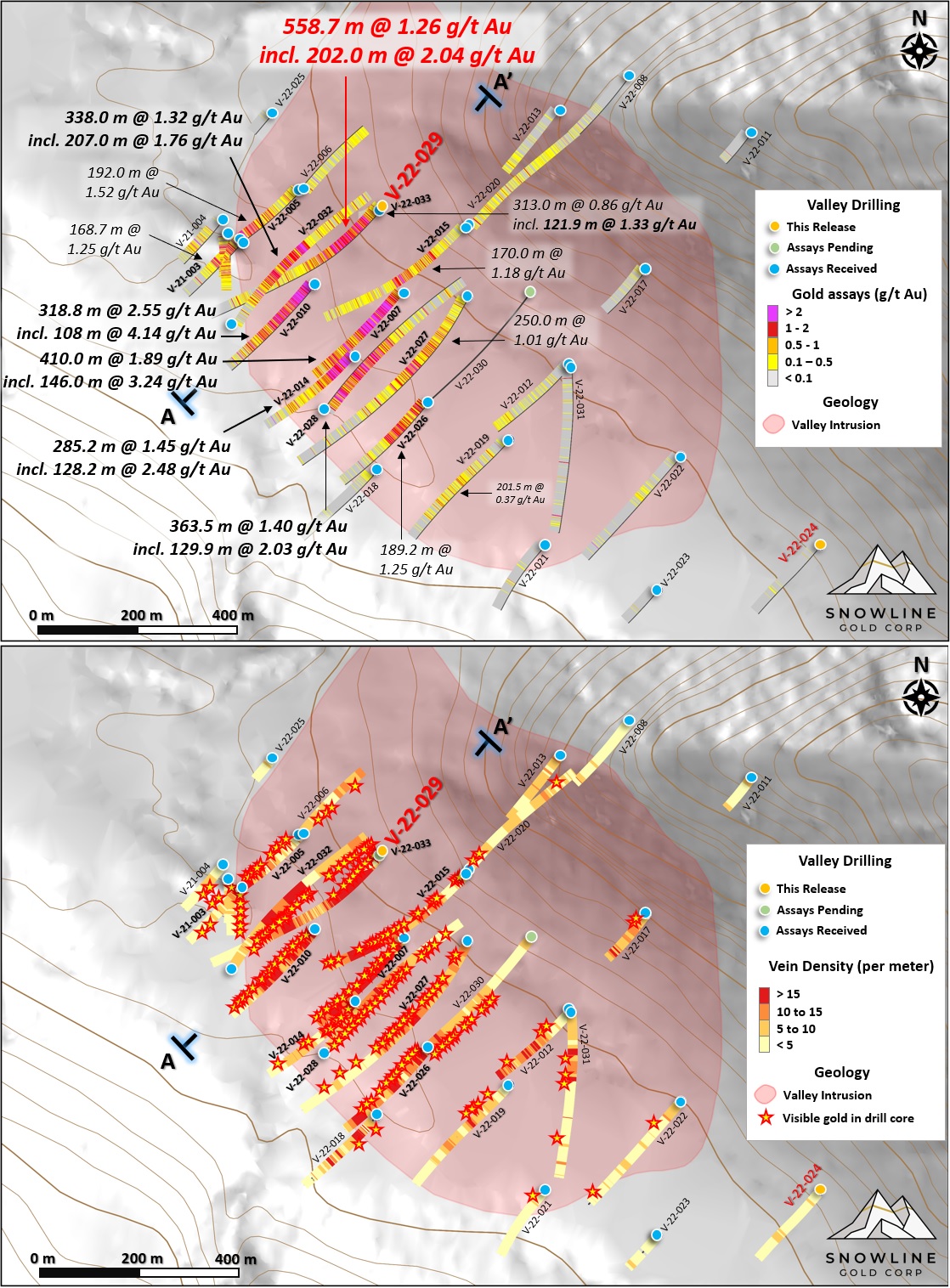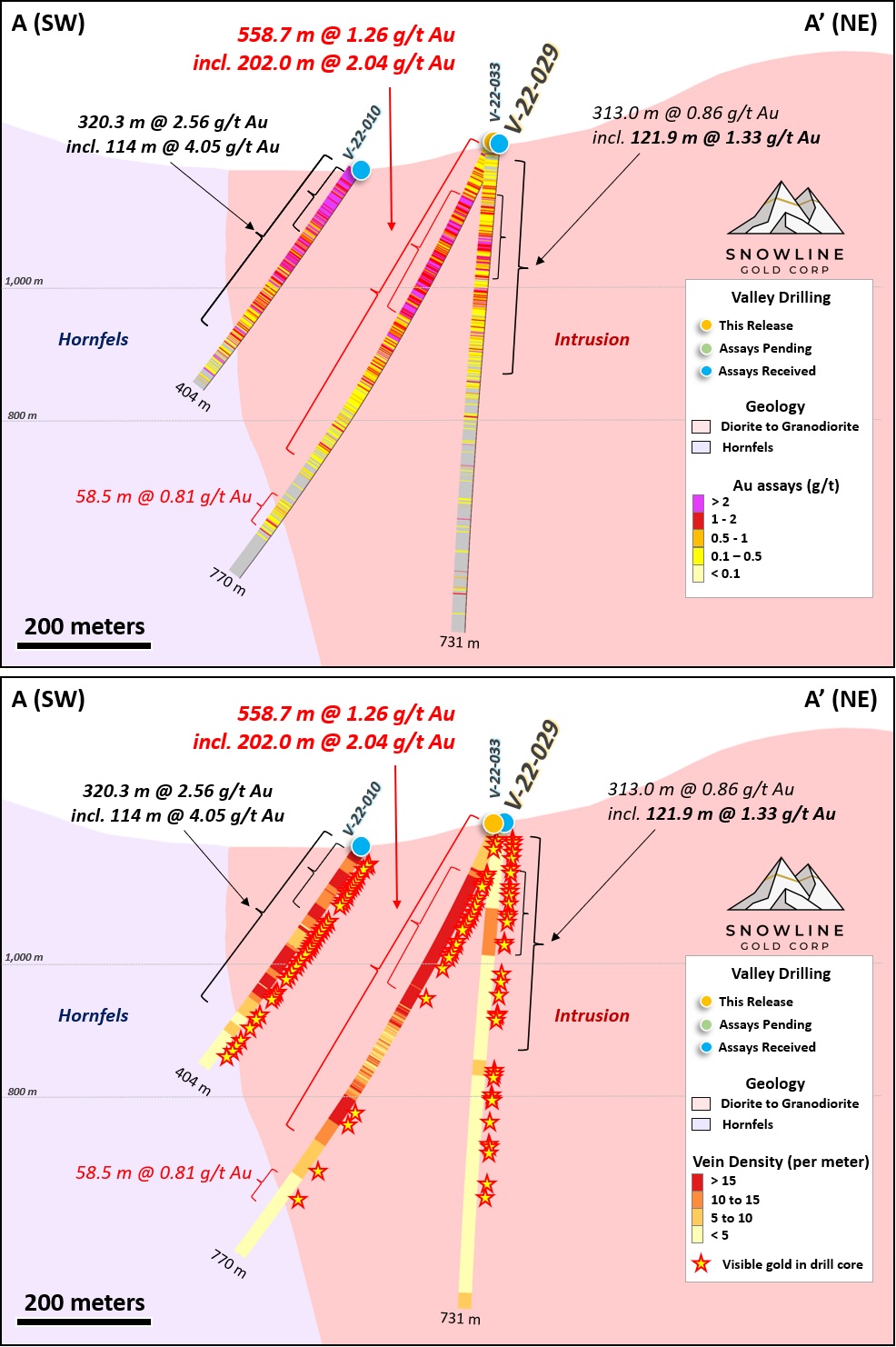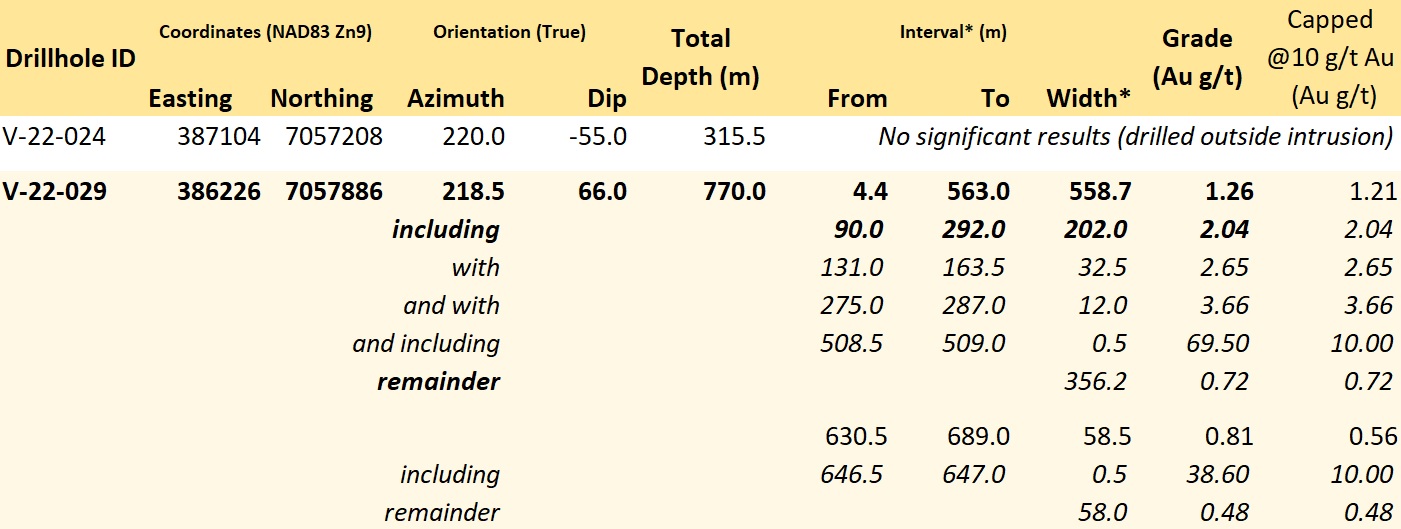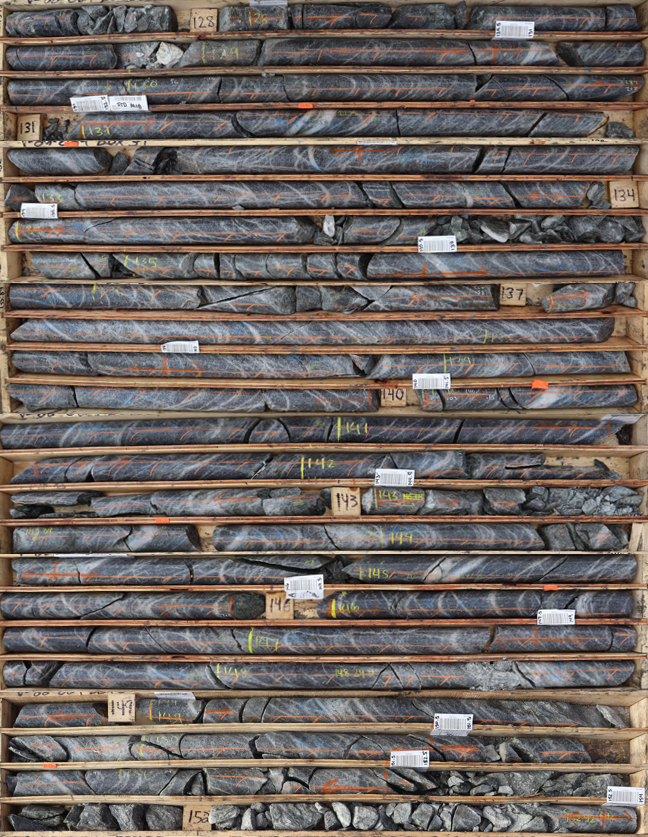- Hole V-22-029 returned 1.26 g/t Au over 558.7 m from surface, including 2.04 g/t Au over 202.0 m in 207 m step-back from previous highlight hole V-22-010
- Longest mineralized intersection to date at Valley, expands width of central high-grade zone significantly to the north and demonstrates strong continuity to depth
- Assays still pending for 3 holes drilled at Rogue in 2022, along with surface results from various targets and properties in Snowline's portfolio.
VANCOUVER, BC / ACCESSWIRE / February 24, 2023 / SNOWLINE GOLD CORP. (CSE:SGD)(OTCQB:SNWGF) (the "Company" or "Snowline") is pleased to announce additional preliminary assay results from its 2022 drilling programs at its Rogue Project in Canada's Yukon Territory. Hole V-22-029 intersected sheeted quartz vein mineralization within the Valley intrusion averaging 1.26 g/t Au over 558.7 m from surface, including 2.04 g/t Au over 202.0 m, with additional mineralization at depth (Tables 1 and 2). The hole was collared at a 207 m step-back perpendicular to strike from V-22-010 (318.8 m @ 2.55 g/t Au from surface) to test the local width of Valley's near-surface, well mineralized corridor and the continuity of mineralization to depth.

Please Click on Image to enlarge.
Table 1 - Preliminary highlight summary of Snowline's latest assay results. *Interval widths reported; true widths of the system are not yet known.
"V-22-029 exceeded our expectations, intersecting strong mineralization much higher in the hole than we originally anticipated and continuing to significant depth," said Scott Berdahl, CEO & Director of Snowline. "It's the longest continuously mineralized interval we've drilled at Valley to date, and like many of Valley's best holes the interval begins at bedrock surface. For perspective, I invite anybody visiting Toronto for PDAC to look at the CN Tower, which stands 553.3 m tall, just shy of the length of this mineralized interval. The scale, grade and continuity of the gold system at Valley continue to impress us, and we look forward to additional results."

Please Click on Image to enlarge.
Figure 1 - 2021 and 2022 drilling at the Valley Zone, showing assays received to date (top) and vein densities alongside instances of visible gold observed during logging (bottom). Visual results indicate the presence of a large central zone within the broader Valley intrusion bearing higher vein densities. Initial analytical results for this zone consistently carry unusually high grades for a reduced intrusion-related gold system.

Please Click on Image to enlarge.
Figure 2 - Cross-section A, showing results received (top) and vein densities alongside instances of visible gold observed during logging (bottom). V-22-029 curves into the page at depth such that the bottom of the hole is roughly 100 m behind section.

Please Click on Image to enlarge.
Table 2 - Summary of mineralization in current holes. Gold intervals are typically long and relatively continuous, with little influence on overall interval grade from unusually high samples evidenced by strong "remainder" assays and strong values after capping assays at 10 g/t Au. *Interval widths reported; true widths of the system are not yet known, with different vein generations, orientations and grade distributions within given intervals through the bulk tonnage gold target.
HOLE V-22-029
Hole V-22-029 was collared within the Valley intrusion and to the north of the known near-surface well-mineralized corridor. The hole was a 207 m step-back along section to the northeast from the collar site for V-22-010 (318.8 m @ 2.55 g/t Au including 108.0 m @ 4.14 g/t Au from surface, see Snowline news release dated October 12, 2022), designed to test the local width of the array of steeply dipping, northwest-striking mineralized quartz veins. Additional mineralized holes V-22-005, 006, 007, 015 and 020 are located between 167 and 177 m from the collar site to the west, south and east (Figure 1), and V-22-033 was collared from the same drill pad.
The hole encountered abundant sheeted quartz veins with trace visible gold, returning 1.26 g/t Au over 558.7 m from bedrock surface at approximately 4.4 m downhole depth, including a higher-grade interval of 2.04 g/t Au over 202.0 m from 90.0 m downhole. Below this, a second zone of mineralization, averaging 0.81 g/t Au over 58.5 m from 630.5 m downhole, was encountered where the drill hole leaves the intrusion at approximately 662.3 m depth. Two 0.5 m intervals of unusually high grade mineralization were intersected at 508.5 m and 646.5 m downhole (69.50 g/t Au and 38.60 g/t Au respectively). These correspond to observations of unusually large (5 to 10 mm scale) bismuth and tellurium minerals in tight spatial association with clusters of trace visible gold.
The hole extends the known width of near surface, >1 gram per tonne gold mineralization at Valley, and demonstrates continuity of mineralization to depths greater than 400 m below surface.
As with previous holes at Valley, gold grades are carried across broad intervals, and they are not heavily affected by local high-grade (>10 g/t Au) intersections (Table 2).

Please Click on Image to enlarge.
Figure 3 - Quartz vein mineralization in V-22-029, from 127.7 m to 152.7 m downhole. The hole encountered high density quartz veining father to the northeast than expected, locally expanding the width of the high-density central vein corridor. Instances of visible gold are marked by orange flags above core. The interval, previously shown in a September 20, 2022 News Release by the Company, averaged 1.47 g/t Au.
QA/QC
On receipt from the drill site, Valley's NQ2-sized drill core was systematically logged for geological attributes, photographed and sampled at Snowline's 2022 field camp. Sample lengths as small as 0.5 m were used to isolate features of interest, otherwise a default 1.5 m downhole sample length was used. Core was cut in half lengthwise along a pre-determined line, with one half (same half, consistently) collected for analysis and one half stored as a record. Standard reference materials, blanks and duplicate samples were inserted by Snowline personnel at regular intervals into the sample stream. Bagged samples were sealed with security tags to ensure integrity during transport. They were delivered by expeditor and by Snowline personnel to ALS Laboratories' preparatory facility in Whitehorse, Yukon. Sample preparation was completed at different facilities in Whitehorse, Sudbury, ON, Thunder Bay, ON and Langley, BC with analyses completed in Vancouver.
ALS is accredited to ISO 17025:2005 UKAS ref 4028 for its laboratory analysis. Samples were crushed by ALS to >70% passing below 2 mm and split using a riffle splitter. 250 g splits were pulverized to >85% passing below 75 microns. A four-acid digest with an inductively coupled plasma mass spectroscopy (ICP-MS) finish was used for 48-element analysis on 0.25 g sample pulps (ALS code: ME-MS61L). All samples were analysed for gold content by fire assay with an atomic absorption spectroscopy (AAS) finish on 30 g samples (ALS code: Au-AA23). Any sample returning >10 g/t Au was reanalysed by fire assay with a gravimetric finish on a 30 g sample (ALS code: Au-GRA21).
Samples with visible gold and other samples returning >2.0 g/t Au by fire assay, along with a set of randomly selected samples, will undergo further processing, analysing the screen rejects to determine whether the screening process could introduce a sampling bias in current results by excluding coarse gold from analysis, resulting in an under-reporting of true grades. Other biases are also possible.
Results reported herein are considered preliminary following receipt of a low but expected percentage of abnormal assays from standard and blank samples inserted by the Company into the Valley sample stream. (Standard samples are prepared by a third-party laboratory to have known quantities of gold, and blank samples are known to contain very limited concentrations of gold.) Reanalysis of samples run along with these reference materials will provide greater certainty in the final assay numbers. These results will be reported if a material difference is identified between the current assays and the re-run sample batches. Based on the widespread and relatively consistent mineralization throughout mineralized zones, however, the Company does not believe that the re-analysis of this relatively small number of samples will have a significant impact on the preliminary mineralized intervals reported herein.
ABOUT ROGUE
Rogue's Valley Zone is a newly discovered, bulk tonnage style, reduced intrusion-related gold system (RIRGS), with geological similarities to multi-million-ounce deposits currently in production like Kinross's Fort Knox Mine in Alaska and Victoria Gold's Eagle Mine in the Yukon. Early drill results demonstrate unusually high gold grades for such a system present near surface across intersections of hundreds of metres. Gold is associated with bismuthinite and telluride minerals hosted in sheeted quartz vein arrays along the margins of and within a one-kilometer-scale, mid-Cretaceous aged Mayo-series intrusion. Valley is an early-stage exploration project without a resource estimate, and while initial results are encouraging, the presence or absence of an economically viable orebody cannot be determined until significant additional work is completed.
The Rogue Project area hosts multiple intrusions similar to Valley along with widespread gold anomalism in stream sediment, soil and rock samples. Elsewhere, RIRGS deposits are known to occur in clusters. The Rogue Project is thus considered by the Company to have district-scale potential for additional reduced intrusion-related gold systems.
ABOUT SNOWLINE GOLD CORP.
Snowline Gold Corp. is a Yukon Territory focused gold exploration company with an eight-project portfolio covering >280,000 ha. The Company is exploring its flagship >137,000 ha Rogue and Einarson gold projects in the highly prospective yet underexplored Selwyn Basin. Snowline's project portfolio sits within the prolific Tintina Gold Province, host to multiple million-ounce-plus gold mines and deposits including Kinross' Fort Knox mine, Newmont's Coffee deposit, and Victoria Gold's Eagle Mine. The Company's first-mover land position and extensive database provide a unique opportunity for investors to be part of multiple discoveries and the creation of a new gold district.

Please Click on Image to enlarge.
Figure 4 - Project location map for Snowline Gold's eastern Selwyn Basin properties. The Valley and Gracie Zones on the Rogue are the sites of Snowline's 2022 drill programs.
QUALIFIED PERSON
Information in this release has been prepared under supervision of and approved by Thomas K. Branson, M.Sc., P. Geo., Exploration Manager for Snowline and a Qualified Person for the purposes of National Instrument 43-101.
ON BEHALF OF THE BOARD
Scott Berdahl
CEO & Director
For further information, please contact:
Snowline Gold Corp.
+1 778 650 5485
info@snowlinegold.com
CAUTIONARY NOTE REGARDING FORWARD-LOOKING STATEMENTS
This news release contains certain forward-looking statements, including statements about the Company's drill program, results, implied significance of visual inspection of drill core, and surface work and plans for exploring and expanding a new greenfield, district-scale gold system. Wherever possible, words such as "may", "will", "should", "could", "expect", "plan", "intend", "anticipate", "believe", "estimate", "predict" or "potential" or the negative or other variations of these words, or similar words or phrases, have been used to identify these forward-looking statements. These statements reflect management's current beliefs and are based on information currently available to management as at the date hereof.
Forward-looking statements involve significant risk, uncertainties and assumptions. Many factors could cause actual results, performance or achievements to differ materially from the results discussed or implied in the forward-looking statements. Such factors include, among other things: risks related to uncertainties inherent in drill results and the estimation of mineral resources; and risks associated with executing the Company's plans and intentions. These factors should be considered carefully, and readers should not place undue reliance on the forward-looking statements. Although the forward-looking statements contained in this news release are based upon what management believes to be reasonable assumptions, the Company cannot assure readers that actual results will be consistent with these forward-looking statements. These forward-looking statements are made as of the date of this news release, and the Company assumes no obligation to update or revise them to reflect new events or circumstances, except as required by law.
SOURCE: Snowline Gold Corp.
View source version on accesswire.com:
https://www.accesswire.com/740633/Snowline-Gold-Intersects-5587-m-of-13-grams-per-tonne-Gold-from-Surface-Including-2020-m-of-20-grams-per-tonne-Gold-at-Its-Valley-Discovery-Rogue-Project-Yukon













